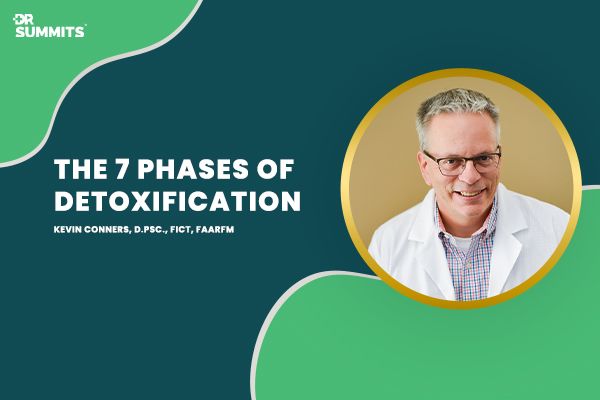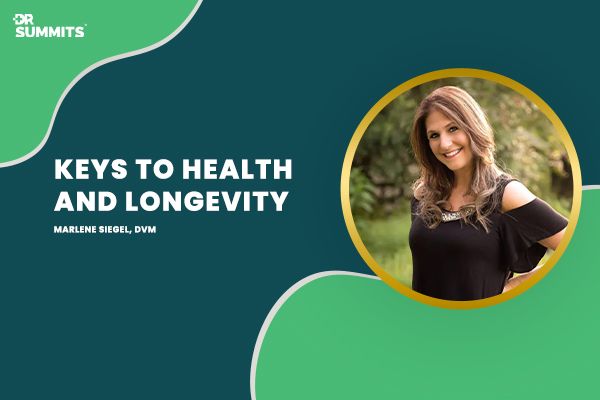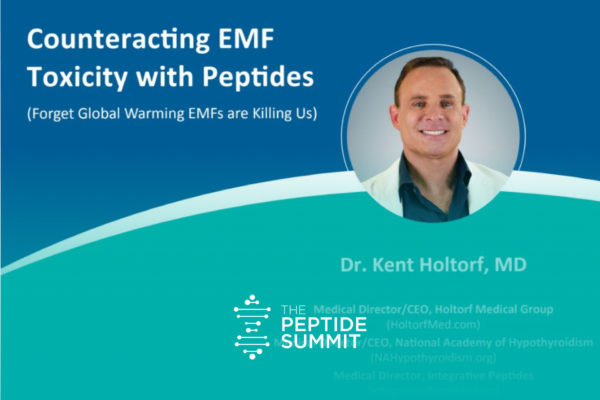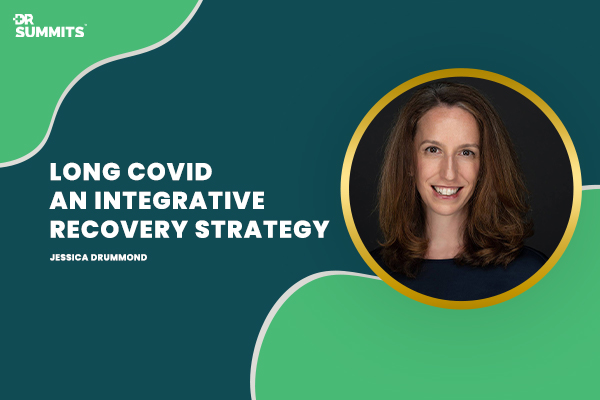Hello, this is Dr. Kevin Conners, and this is gonna be a video talking about my new book called “The 7 Phases of Detoxification.” So I’m gonna go over some of the details of the book in this short video so people that don’t have time to read can at least get a preview of the book. It’s a free download. So go to our website, connersclinic.com. You can download it for free. It’s not that long, but it gives you some ideas on things that you want to do when you’re considering going through a detoxification program. Now, those of you that have listened to me in the past know that I’m not a big fan of box detoxes because of what I really wrote in this book. You really have to go through all these phases of detoxification. Now, understand you can do many of these concurrently, but if you’re not dealing with these seven phases, at least concurrently, you are setting yourself up for possible problems.
So let’s walk through what I mean by these seven phases of detoxification so you can better understand it. Many of you understand a lot of these pieces. I’m just trying to put them together for you. So, detoxification, everybody thinks of that as dealing with poisons in your liver, doing what your liver is supposed to do. When people talk about the phases of detoxification, usually they say phase one and phase two. They might expound it to phase one, two, and three. They’re really talking about specific phases of detoxification that are going on in your liver. And I incorporate those in the phases of detoxification because obviously they’re very important. But there’s other phases that you ignore to your own peril, and we need to deal with those. No one would argue that we are poisoned today. We are being poisoned in our environment. We’re being poisoned by things we eat. Don’t mistake yourself that it’s just things that we eat, though.
You are receiving toxins from things that you put on your skin. You’re receiving toxins from things that you breathe. The fastest way to poison yourself is through an injection. So people are getting vaccines with a bunch of adjuvants in them, with all sorts of unknown things in them. Those things are going right into your bloodstream, right into your tissues, and often right across the blood-brain barrier and damaging things. You choose to do that, you have to be really supporting liver detox pathways so you can get these toxins, these poisons, out of your body. But things that you’re putting on your skin on a daily basis from deodorant to lotions, to creams, to beauty supplies, and makeup and things have just an enormous amount of poisons in them that are cancer-causing poisons that absorb through your skin, that get into your bloodstream, and can wreak havoc in your body and overwhelm your liver. It’s easy to think about pesticides and herbicides. There’s a lot of knowledge about those, GMO foods. Things that we’re breathing in, things that we’re absorbing through the gut all affect us in many different ways. Don’t think that it’s just your liver or your tissues that are being harmed. Probably the most common detrimental effect to toxicities and overwhelmed detoxification pathways is the brain. We’re seeing such an uptick in early dementia, Alzheimer’s disease, demyelinating diseases, that you have to look at the damage that is being done to the brain, the neurons, and most importantly, the glial cells of the brain that is causing these problems. And it’s most often caused from toxicities that are supposed to detox through these liver pathways, but because of different backups that we’ll talk about and things that we need to support, they continue to circulate and then damage the blood-brain barrier or cross an intact blood-brain barrier and then cause all sorts of problems in inflammation in the brain, microglial priming, et cetera. And I have some videos on that that you should look at, too.
So when we talk about the seven phases of detox, we have to start at the last phase. So you think the last phase is phase seven, but actually it’s phase zero through six because I had to put it in order to tie in the liver phases. So phase six is really the end game, the last stage of detoxification. And it really has to do with proper elimination. If you’re not eliminating through your kidneys, through your urine, through your bowels, through your feces, properly, in a healthful manner, you’re going to be reabsorbing poisons. You’re gonna be toxifying your kidneys, and you’re gonna end up with early death. So people will often tell me that they, oh, they have normal bowel movements. They go at least a couple times a week. That is a severe constipation. Even people that are having normal bowel movements and going once a day, it’s better to go two or three times a day. But if you’re even having a bowel movement once a day, you really also wanna look at your intestinal transit time, how long is it taking for things that you eat today to get into your stool. Is it one day? If you ate corn today, would you see it in your stool tomorrow? Or will it take three or four days to see it in your stool? If it’s taking three or four days, you have a very slow intestinal transit time, the time it takes for something you eat to get into the toilet.
If you have that long intestinal transit time like that, you have feces backed up in your colon, even if you’re having a daily bowel movement. And when you do, you are absorbing a lot of the poisons that your liver is getting out or that your intestinal wall is preventing from being absorbed. So we eat poisons. We’re consuming different things in our foods and in our environment that we’re swallowing, that’s getting into your gut that shouldn’t cross the gut border. So if I have an intact gut border, if I don’t have leaky gut, I have a healthy gut border, but I have a long intestinal time, I can end up absorbing some of these things that I’m not supposed to be absorbing, even if I don’t have leaky gut. Also, if my liver is doing its job and dumping poisons, toxins, from the blood that I absorb through the gut, or I absorb through breathing, or I absorb through injection or whatever, and my liver has done its job, it’s throwing the toxins into the small intestine, goes through the large intestine. And if I have a slow intestinal transit time, long intestinal transit time, so food is going slowly through the gut, I’m gonna reabsorb those things. So we have to be eliminating properly. So some things to consider to help with elimination is using magnesium with vitamin C before you go to bed, using a product called cape aloe. That works very well, increases peristaltic waves. So does senna. So it can really help move things through the gut. Increasing your fiber simply using prune juice or fig or plum, that can be very helpful. With more stubborn constipation, a product called cascara sagrada works well. You only wanna use that short term. And then using coffee enemas. Nobody likes to talk about coffee enemas, but since we’re mainly a cancer clinic, in our office, we talk about coffee enemas all the time with joy. Coffee enemas can be beneficial to help with elimination, but really the reason why we push coffee enemas is really to stimulate your parasympathetic nervous system.
So think of your nervous system split into two sides. You have your voluntary nervous system, like, move this arm, and you have your involuntary nervous system, heartbeat, liver detoxify. All your organ function that you don’t have to think of is a function of your autonomic nervous system. Think automatic nervous system. Well, your autonomic nervous system is then separated into two different opposing categories, your sympathetics and your parasympathetics. Your sympathetics are your fight or flight or flee mechanism or your fight or flight or freeze mechanism. It’s how you deal with stresses. So if a polar bear jumps down in front of you, your sympathetics kick in and do very specific things to help prepare you to either fight that polar bear or run away. Your blood pressure goes up. Your smooth muscles outside of your arteries contracts.
That increases your blood pressure, shunts blood to the extremities, so you can run away from that polar bear or that you can fight. Your eyes will dilate. Your bronchial tubes will dilate so you can get oxygen in your tissues as fast as possible to be able to run away from that bear. That is your sympathetic nervous system. It has a very distinct purpose that is very necessary. So it is not a bad guy. It just has to be in balance with the other side of the nervous system called your parasympathetics. Your parasympathetics are your rest-and-relaxation side of the nervous system. But it’s also, your immune function is controlled solely by your parasympathetics, your detoxification pathways, your sexual function. All these are controlled by your parasympathetics. So think of anything that you don’t really need to function well if you’re running away from a polar bear.
You don’t need to think about detoxifying mercury if you’re running away from a polar bear. So that is a parasympathetic function. You don’t need to consider procreation if you’re running away from a polar bear. That is a parasympathetic function. The problem is is that we live in a society that we’re so stimulated with stressors that we, most of us, are imbalanced on the side of sympathetic dominance. So our sympathetic nervous system is stressed because of deadlines, because of just lifestyle that we live in this country, that we’re in a state of sympathetic dominance. Our parasympathetic is low on that teeter-totter and is deficient. So then what is lacking? If we’re sympathetic dominant, our immune system is gonna be shut down. Our detoxification is gonna be shut down. Everything’s gonna be slower.
We’re gonna be poisoning ourselves even if we’re eating really healthy and doing everything right. If we have a sympathetic dominance, we’re going to be poisoning ourselves. This is where we talk with our cancer patients so insistently that they need to deal with their anxiety in life. We either get counseling, use of adaptogenic herbs. You have to develop some relationships so that you can reduce that level of anxiety ’cause anxiety is gonna push that sympathetic drive and is gonna shut down parasympathetics. What do you need to do to conquer cancer? You need a healthy immune system. You need a healthy detoxification pathway system. Your liver is gonna basically be shutting down if you’re in a sympathetic drive, or a sympathetic dominance is what it’s called. Why does this have anything to do with coffee enemas? Well, coffee enemas, really the main purpose of coffee enemas is to get coffee, caffeine, into that lower rectal area where cranial nerve 10 can be stimulated.
Cranial nerve 10, or your vagus nerve or your vagal nerve, is really your primary nerve system of your parasympathetics. So you stimulate the parasympathetics by doing coffee enemas. A side effect of coffee enemas is if you have some constipation, you will help relieve that constipation. But we don’t tell people to do coffee enemas for constipation. We tell people to do coffee enemas to stimulate their parasympathetic nervous system. When you stimulate your parasympathetic nervous system, you are gonna stimulate detoxification, your liver function. You are gonna stimulate your immune system to fight off disease, whether it’s cancer or a virus or bacteria or any other pathogens. You want to be stimulating that parasympathetic. And then you will also, contrast-ly, by stimulating the parasympathetics by using coffee enemas to stimulate that vagal nerve, you will suppress the sympathetics. So you will decrease anxiety.
One of the common comments that we get from our cancer patients is that people feel much more relaxed after doing a coffee enema. Why? It’s because you’re stimulating the parasympathetics and calming the sympathetics. It is just straight neurology. So don’t shy away from doing coffee enemas. Phase five, the next thing that we want to move upstream here is helpful binding. So remember we talked about intestinal transit time. Food sits in your colon for a period of time, especially if we have leaky gut, which pretty much everybody does because of foods that they eat. GMO foods are basically, act as antibiotics and damage our gut wall. The epithelial lining of the gut becomes damaged. That’s called leaky gut.
So things get across the gut that shouldn’t be getting across the gut, just overwhelming our detox pathways, stimulating immune system hyper function, increasing inflammatory cytokines. The list goes on and on, the damage that leaky gut does. If we could use binders, so binders are things that, intestinal binders are now a kind of a class of nutraceuticals that help grab onto things in the gut and keep it in the gut. So, fiber, things in your diet that would qualify as an intestinal binder would be fiber that you’re eating in your food. That acts as an intestinal binder. It holds things in the gut so that you don’t reabsorb them. Now here’s a list of some different nutraceutical intestinal binders, humic and fulvic acid, zeolite, bentonite clays, other different clays, activated charcoal, sodium alginate. And as I said, fiber and aloe and chitosan act as binders. They grab onto things in the gut so that you don’t reabsorb them, and that’s the whole idea. You don’t want your liver doing its job through phase one, phase two, phase three, dumping things into the small intestine. Now it gets into the large intestine, and it gets reabsorbed. I mean, if you think of it that way, that stuff that’s getting reabsorb is now circulating through the bloodstream again. And if you could kind of put it into a cartoon idea that your liver’s going, what in the Sam beans am I dealing with you again? Didn’t I just dump you in the colon three days ago? What is going on? So we really could overwhelm our liver by allowing things to reabsorb. It’s very common for estrogens. Bad estrogens that our body is getting rid of reabsorb in the gut, and then they can cause all sorts of problems.
And we deal with this with any horrible driving cancers. You wanna be binding these things in the gut so that you don’t reabsorb them in the small intestine. Using an intestinal binder could be very beneficial. And then phase four, so understand we’re kind of just going upstream. You gotta start at the bottom of the stream. I like that analogy when you talk about detoxification, if we’re throwing stuff in the Mississippi in Minneapolis, thinking that we’re getting rid of it, but there’s a blockage in the Mississippi and St. Louis, all we’re doing is poisoning the waterway all the way down. And it’s seeping into other waterways and poisoning the ground all the way down. And it’s probably a bad example ’cause that’s probably exactly what is truly happening with our rivers, but we don’t want that to happen in our body.
So if we are trying to bind things in the gut, and we’re trying to now phase four, work on bile flow, and phase three and phase two and phase one that we’ll talk about in a minute, we’re supporting all these liver detox pathways, but we’re constipated, all we’re gonna be doing is reabsorbing this stuff no matter how many binders you use. You have to work on phase six, phase five, phase four. Now again, you can do these concurrently, but you have to work on all of these, or we’re really just circulating poisons around our body instead of detoxifying poisons. If they’re not ending up in the toilet, they’re still in our body. So phase four, bile flow. So understand what bile is. So bile is a nutrient, let’s call it that, a chemical that’s made in your liver. So it’s made in your liver, and the purpose of bile is to put into it poisons from phase-one and phase-two pathways in the liver.
So phase three, which we’ll talk about in little bit, is actually creation of bile. And phase four, then, is that bile then flows down the bile ducts into the gallbladder. And don’t worry if you had your gallbladder removed. Still this function still takes place. So the purpose of bile is to carry toxins from the liver into the small intestine. The second purpose of bile is also it functions as an emulsifier for fat. So bile helps break down fats that you eat and consume and go into your stomach and then into your small intestine. And it carries with it poisons from your liver that your liver did a great job filtering out the blood, getting those poisons out of the blood, putting it in the bile, flows in through the bile duct, into the gallbladder. And it sits in the gallbladder until you eat something fatty. And then when you eat something fatty, that causes contraction of the gallbladder walls, squirts bile down the common bile duct into the first part of the small intestine along with pancreatic enzymes like lipase to help digest fat. It helps digest fat, and it is carrying all those poisons from the liver into the small intestine. Now, those people that have not done phase four, meaning that they’ve not helped with bile flow, can end up with bile stasis, and that can cause gallstones. And then if you have a gallstone attack, meaning an inflammatory process going on in place with a lot of pain, and you go in, get an ultrasound, and they say “We’re gonna remove your gallbladder,” they get their gallbladder removed. Well, they still have bile flow. They still have the same bile production. Now they get a bile flow that’s a trickle into the small intestine at all time. Maybe not adequate when you eat a fatty meal to deal with that, to help digest and emulsify the fats with that meal. That’s a whole nother story.
You might have to take some ox bile or some more lipase to help digest fats or break down your meals where you’re not eating a lot of fat at any given time because of the lack of gallbladder. But you still have bile flow, so you still need to work on this whether or not you have a gallbladder. So things that you wanna work on with bile flow are taking, and this is similar to, some of these things are same with the next phase that we’re gonna talk about, taking phosphatidylcholine ’cause that’s a precursor to production of bile. Using nutrients that have artichoke leaf, ginger, dandelion, taurine, and glycine can be really helpful to decrease the viscosity of bile so that it will flow better. But very simple things that you could do are putting a hot pack over your liver/gallbladder area. Castor oil packs are really good, but they’re messy and tend to take more time and clean up and such.
So if you just use a hot pack, that could be very beneficial. Again, coffee enemas are super beneficial for this also. Why? Because it stimulates the parasympathetics and your muscles of your ducts. They have smooth muscles that layer underneath the epithelial layer of the duct work, are controlled by sympathetics. And sympathetic tone can increase that tone and decrease the flow. So if you could open that up stimulating the parasympathetics with coffee enemas, it can be very helpful as well. And then we could get into more detail with liver/gallbladder flushes. Make sure that you have a practitioner that you’re working with with the liver/gallbladder flushes. And I do have details in my book and on our website and different blogs on the details of the liver/gallbladder flushes. Phase three is really bile creation, and bile creation has to do with all those things that we talked about with bile flow, really these top things here, phosphatidylcholine, artichoke leaf, ginger, and dandelion.
You need to support creation of bile and bile flow. That’s phase three, using those products to help support that. Phase two is really conjugation. Conjugation is a word that means when the byproducts of phase one, So remember you got poison circulating through your body, it goes through the liver. The blood goes through the liver, and it moves out into the liver going through phase one detoxification. Phase two detoxification then takes the poisons from phase one. Often after phase one, phase one changes. Through phase one, you have different genes that make different enzymes that cause often a more poisonous end product than the poison itself in order to make this toxin water soluble so that in phase two, it can be conjugated and then put into the bile. So things that will help with phase one, phase two, are these types of products. And I’m not gonna just read them off here because they’re both phase one and phase two. Now we always suggest when you’re looking at phase-one, phase-two function, you look at your gene pathways because there’s very specific genes, the P450s, PON1 genes, and many others that actually are the process in how we make the specific enzymes for phase-one and phase-two liver functions to actually take place. So when a person has defects on many of these genes in these gene families, there’s many, many genes in the P450s and the PON1 pathways. If I have a lot of defects in my P450s, I’m already predisposed to slower phase-one liver function. So if I have a lot of defects on my P450 pathways, but my next-door neighbor has very few defects on their P450 pathways, and we have very similar lifestyles, we don’t abuse alcohol. We haven’t abused other toxins in our life.
Let’s pretend our livers are equally as healthy, but I happen to have inherited a lot of defects on my P450 pathways from my parents, my phase-one pathways are going to be slower. So I’m gonna be a slower detoxer. Let’s say both my neighbor and I both go out to the golf course and play golf. We’re exposed to the same amount of glyphosates from that golf course. And now I might have issues from it. He has none because his phase-one pathway is larger, so as those glyphosates enter his bloodstream, they are able to filter out through phase-one, phase-two detoxification pathways, dump into his small intestine, and be deposited ultimately into the toilet, where mine, the glyphosate circulates around the blood again, circulates around the blood again, basically asking, hey, liver, can we come in? Hey liver, could we get out of this body? And the liver, because of my defects, slower pathways are like, hey, we’re overwhelmed at the time. Wait till next time.
That’s how toxins get shunted to your extracellular spaces and then into your cells. And that’s really the problem. I like to kind of make a cartoon of it, but that’s really what’s taking place. When toxins get into our bloodstream, they circulate around our blood and go through the liver. If the liver can take that toxin at that time, it accepts it. If our liver is overwhelmed because of issues with our genetic pathways, so giving me slower phase-one, phase-two pathways, because of just over-exposure to poisons, I’m out of the golf course all the time, and I’m exposed to a lot of glyphosates and poisons and herbicides and pesticides and whatever, or I’m eating a poor diet or I’m drinking a lot of alcohol or list goes on, right? If I’m overwhelming my liver, my liver’s gonna say, hey, we’re at capacity. We can’t take you. It continues to circulate around the body. And eventually it’s gonna be pushed outside of the bloodstream into the extracellular spaces. That in itself could do damage.
It could cross in through a cell membrane into the cell. It could do major damage there. If it damages or effects the nucleus of the cell, it can cause rapid replication. This is how toxins, pesticides, herbicides, chemicals, heavy metals, et cetera, get inside the cell, affect the nucleus, and can be a cause of cancer. So we deal with this all the time. You have to support phase six, phase five, phase four, phase three, two, one before you start pulling it out of the tissues. So hopefully you’re understanding this process. It’s really like a stream. We have to pull it out of the tissues ’cause it’s causing cancer or causing symptoms, causing brain inflammation. But you better make sure that you don’t just pull it out of the
tissue using a chelator of some sort, and there’s no way it’s gonna get through the liver ’cause we haven’t addressed any of that. So it’s just gonna circulate somewhere else and be deposited in some other tissue and cause damage somewhere else. And we see this all the time. We don’t wanna let this happen. Again, these things can be done fairly concurrently, but you need to work on all these phases. Then phase zero is pulling it out of the tissue. So things that you’d use to pull toxins out of the tissue are chelators. I have a list of multiple chelators in my book, and that’s where people tend to gravitate to want to go to first. Hey, I have heavy-metal toxicity, so I’m gonna start using some sort of chelating agent. Even a mild chelator, still, if you’re not dealing with the liver and that beyond that, you’re going to possibly just cause more harm than good. And I just warn you against it.
That’s really why I wrote this book. Other things to consider, and this is what some people, everybody, should do, is make sure you’re decreasing exposure as best as you possibly can. Consider doing fasting or fasting-mimicking diet or time-restricted eating. That can be one of the most healthful things for a person to do. You’re just decreasing the burden on your organs when you do this. Everybody should be eating organic as best they possibly can. You should eliminate as best as you possibly can GMO foods, damages your gut, causes leaky gut, causes all sorts of problems. Use clean products for your house. Everybody thinks of their diet, and it’s so important when you’re trying to decrease exposure, and then they’re using Lysol in their house or something like that with all sorts of toxins that our ancestors were just never exposed to. Stop using cleaning products that are poisonous.
Stop using personal care products that are poisonous. I interviewed a gentleman who is a specialist in this, and I always refer to this ’cause it was mind-boggling to me. There’s over 1,300 chemicals used in personal care products in the United States that are banned in the European Union because they’re cancer-causing. But they’re allowed in the US, mind-boggling. We are exposed to so many poisons in our personal care products. And, women, it’s just so much worse for you, using makeup and things like that. So be conscious of those. Make different choices and just starting to become more conscious of just things that you’re doing and you’re exposed to. Just making different purchasing choices and lifestyle choices are gonna be the most beneficial for people. So, remember, a cap on this, proper elimination, helpful binding, binding things in the gut, helping bile flow with heat packs and stuff over your liver, bile production and use of bile, conjugation in the P450s.
That’s the specific liver things that people tend to want to go to first, and often wanna go to first is starting to chelate things out of their body. You wanna really do that last. So if you can follow these steps, these seven phases of detox, you’re gonna have a better detoxification process, and it’s really not just a two-week thing. This is a lifestyle. So this is you have to be working on this constantly. So this is really a lifestyle thing. It’s not a two-week detox program. And if you can think of it that way, you’re gonna be better because if you are not detoxifying properly, you are damaging tissue, and you’re increasing your risk for serious diseases such as cancer. So you want to be doing this constantly on a daily basis. All right, this is Dr. Kevin Conners. Again, you can find my book, “The 7 Phases of
Detoxification” on our website along with all my other books on our website. They’re all a free download, so there’s no excuse for not having information. So, go get it. All right, bye-bye.








